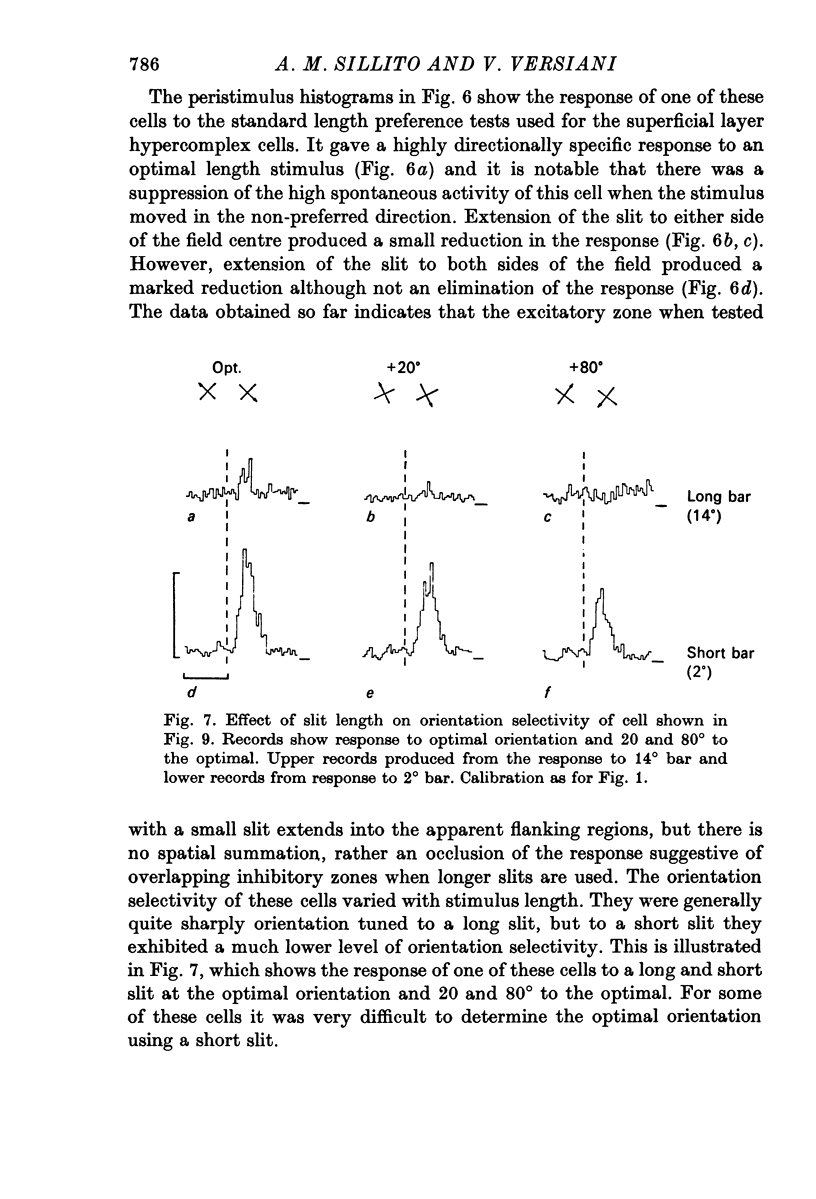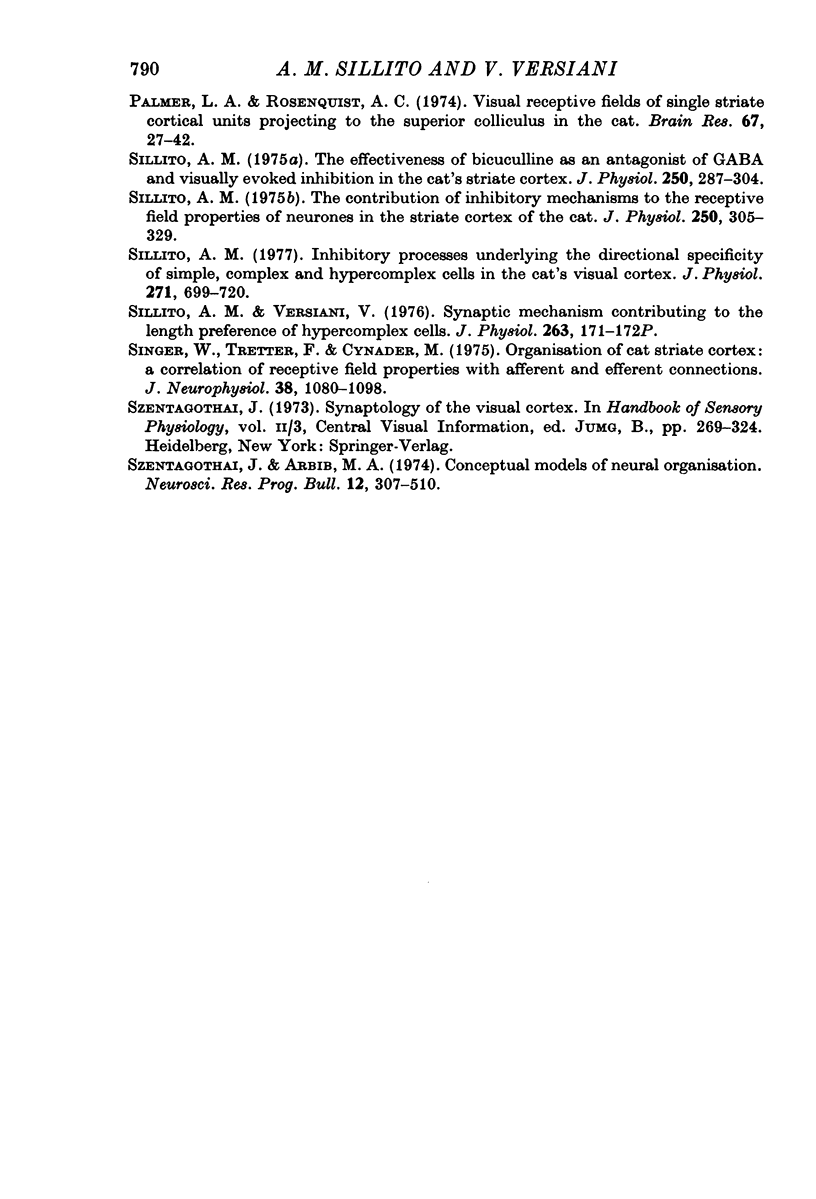Abstract
1. The GABA antagonist bicuculline has been applied to hypercomplex cells in layers II and III of the cat's striate cortex in an attempt to test the hypothesis that their length preference derives from the action of a GABA mediated post-synaptic inhibitory input.
2. Iontophoretic application of bicuculline to these cells resulted in a reduction but not an elimination of the length preference. The reduction in length preference was only observed in the case of slits extended to one side of the receptive field or to slits only partially covering what appeared to be inhibitory flanking regions either side of the field centre. In cells normally showing a clear and stable length preference it was never possible to produce by the application of bicuculline a significant response to a slit fully extended to cover both flanking regions.
3. The orientation tuning was basically eliminated by the application of bicuculline. In contrast the directional specificity was relatively unaffected.
4. The action of bicuculline on hypercomplex cell orientation tuning supports the view that GABA mediated inhibitory inputs were effectively blocked and suggests that the partial effect on length preference and lack of effect on directional specificity reflect the varying degree of involvement of a GABA mediated inhibitory input to these receptive field properties.
5. These observations introduce the possibility that the excitatory input to the superficial layer hypercomplex cells exhibits directional specificity, length preference with respect to a slit extended to both sides of the field and a low degree of orientation selectivity. Evidence is presented indicating that certain layer V cells with hypercomplex type receptive field properties exhibit some of the characteristics required of this input.
Full text
PDF















Selected References
These references are in PubMed. This may not be the complete list of references from this article.
- Blakemore C., Van Sluyters R. C. Reversal of the physiological effects of monocular deprivation in kittens: further evidence for a sensitive period. J Physiol. 1974 Feb;237(1):195–216. doi: 10.1113/jphysiol.1974.sp010478. [DOI] [PMC free article] [PubMed] [Google Scholar]
- Camarda R., Rizzolatti G. Receptive fields of cells in the superficial layers of the cat's area 17. Exp Brain Res. 1976 Feb 26;24(4):423–427. doi: 10.1007/BF00235007. [DOI] [PubMed] [Google Scholar]
- Dreher B. Hypercomplex cells in the cat's striate cortex. Invest Ophthalmol. 1972 May;11(5):355–356. [PubMed] [Google Scholar]
- Fisken R. A., Garey L. J., Powell T. P. The intrinsic, association and commissural connections of area 17 on the visual cortex. Philos Trans R Soc Lond B Biol Sci. 1975 Nov 20;272(919):487–536. doi: 10.1098/rstb.1975.0099. [DOI] [PubMed] [Google Scholar]
- Garey L. J. A light and electron microscopic study of the visual cortex of the cat and monkey. Proc R Soc Lond B Biol Sci. 1971 Oct 12;179(1054):21–40. doi: 10.1098/rspb.1971.0079. [DOI] [PubMed] [Google Scholar]
- HUBEL D. H., WIESEL T. N. RECEPTIVE FIELDS AND FUNCTIONAL ARCHITECTURE IN TWO NONSTRIATE VISUAL AREAS (18 AND 19) OF THE CAT. J Neurophysiol. 1965 Mar;28:229–289. doi: 10.1152/jn.1965.28.2.229. [DOI] [PubMed] [Google Scholar]
- HUBEL D. H., WIESEL T. N. Receptive fields, binocular interaction and functional architecture in the cat's visual cortex. J Physiol. 1962 Jan;160:106–154. doi: 10.1113/jphysiol.1962.sp006837. [DOI] [PMC free article] [PubMed] [Google Scholar]
- Henry G. H., Dreher B., Bishop P. O. Orientation specificity of cells in cat striate cortex. J Neurophysiol. 1974 Nov;37(6):1394–1409. doi: 10.1152/jn.1974.37.6.1394. [DOI] [PubMed] [Google Scholar]
- Hubel D. H., Wiesel T. N. Receptive fields and functional architecture of monkey striate cortex. J Physiol. 1968 Mar;195(1):215–243. doi: 10.1113/jphysiol.1968.sp008455. [DOI] [PMC free article] [PubMed] [Google Scholar]
- Iversen L. L., Mitchell J. F., Srinivasan V. The release of gamma-aminobutyric acid during inhibition in the cat visual cortex. J Physiol. 1971 Jan;212(2):519–534. doi: 10.1113/jphysiol.1971.sp009339. [DOI] [PMC free article] [PubMed] [Google Scholar]
- OTSUKA R., HASSLER R. [On the structure and segmentation of the cortical center of vision in the cat]. Arch Psychiatr Nervenkr Z Gesamte Neurol Psychiatr. 1962;203:212–234. doi: 10.1007/BF00352744. [DOI] [PubMed] [Google Scholar]
- Palmer L. A., Rosenquist A. C. Visual receptive fields of single striate corical units projecting to the superior colliculus in the cat. Brain Res. 1974 Feb 15;67(1):27–42. doi: 10.1016/0006-8993(74)90295-9. [DOI] [PubMed] [Google Scholar]
- Sillito A. M. Inhibitory processes underlying the directional specificity of simple, complex and hypercomplex cells in the cat's visual cortex. J Physiol. 1977 Oct;271(3):699–720. doi: 10.1113/jphysiol.1977.sp012021. [DOI] [PMC free article] [PubMed] [Google Scholar]
- Sillito A. M. The contribution of inhibitory mechanisms to the receptive field properties of neurones in the striate cortex of the cat. J Physiol. 1975 Sep;250(2):305–329. doi: 10.1113/jphysiol.1975.sp011056. [DOI] [PMC free article] [PubMed] [Google Scholar]
- Sillito A. M. The effectiveness of bicuculline as an antagonist of GABA and visually evoked inhibition in the cat's striate cortex. J Physiol. 1975 Sep;250(2):287–304. doi: 10.1113/jphysiol.1975.sp011055. [DOI] [PMC free article] [PubMed] [Google Scholar]
- Sillito A. M., Versiani V. Synaptic mechanisms contributing to the lenght preference of hypercomplex cells [proceedings]. J Physiol. 1976 Dec;263(1):171P–172P. [PubMed] [Google Scholar]
- Singer W., Tretter F., Cynader M. Organization of cat striate cortex: a correlation of receptive-field properties with afferent and efferent connections. J Neurophysiol. 1975 Sep;38(5):1080–1098. doi: 10.1152/jn.1975.38.5.1080. [DOI] [PubMed] [Google Scholar]
- Szentágothai J., Arbib M. A. Conceptual models of neural organization. Neurosci Res Program Bull. 1974 Oct;12(3):305–510. [PubMed] [Google Scholar]


